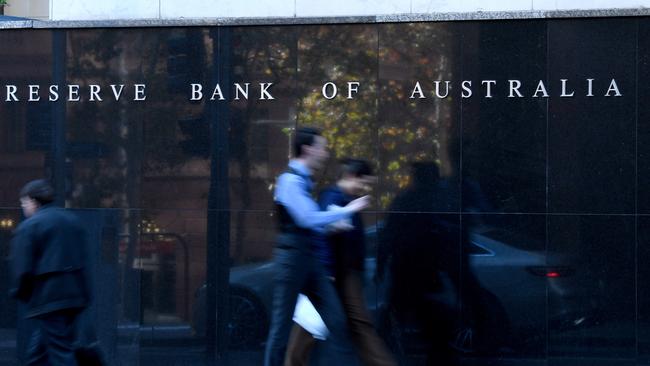Terry McCrann: RBA delivers the certainty we need
The Reserve Bank is providing the foundation of stability that is so crucial at this time of plague, economic devastation and just general fear and uncertainty, writes Terry McCrann.
Terry McCrann
Don't miss out on the headlines from Terry McCrann. Followed categories will be added to My News.
The Reserve Bank will continue to do exactly what it needs to do to provide the foundation of stability that is so crucial at this time of plague, economic devastation and just general fear and uncertainty.
Importantly, it is not just any old ‘stability’, but pro-active stability – the stability that supports both consumers and businesses and indeed governments, state and federal, which are doing the necessary spending like JobKeeper and JobSeeker and other specific initiatives at the state level.
There are a series of key components in what the RBA is doing which combine to ensure that individuals continue to get low-interest rates on their home loans – the biggest financial exposure of households; business gets access to funding also at (relatively) low rates; and that governments, obviously especially Canberra, can spend without fear of a ‘deficit problem’.

So the RBA’s official interest rate has been set at just 0.25 per cent and the RBA has promised it will stay there pretty much into the foreseeable future. This was emphatically reinforced by Tuesday’s statement.
All bank loan interest rates, to both home loan borrowers and business, are set off this.
Critically, the RBA has also committed to lend banks up to $90bn at that 0.25 per cent. The base rate plus this lending ensures the banks won’t be artificially limited in either the amount of lending they make or the rates at which they are made.
So far banks have used $29bn of the $90bn, so they are at no risk of running out of cheap finance to underwrite their lending. Importantly, they are also under no pressure to default borrowers who can’t service their loans simply because they have been hit by the lockdowns.
Further, while the RBA has set the figure at $90bn, if more was required as we moved into 2021, I have absolutely no doubt it would be prepared to go higher, and indeed much higher.
The same applies to the other key element in its stability framework – keeping the three-year yield on government bonds also at that 0.25 per cent.
This gives the government a blank cheque to spend as much as it takes to offset the economic slump. So far that spending has been concentrated on incomes transfers – handing money to people via JobKeeper and JobSeeker.
They will continue, albeit at reduced levels, into 2021. So the budget will stay in deficit. The government will issues bonds to cover the deficit, and the RBA will buy them in the marketplace, if necessary, to keep the yield from rising above 0.25 per cent.
What is not well appreciated is the RBA would continue to do this if the government embarked on more direct spending to create jobs.

No, the RBA is not buying the bonds directly from the government.
First, it doesn’t have to – so far the yield has stayed pretty much at the 0.25 per cent; although yesterday’s statement, noted that the yield had moved slightly higher and so the RBA would be buying some bonds in the market.
But secondly, to embark on such an exercise – in a form of the MMT theory which has become inanely fashionable in some quarters – would both detract from its comprehensive stability foundation and introduce uncertainty to absolutely no positive point.
This goes to the broader point. Nothing would be achieved by the RBA ‘fiddling’ with any of this. Would anyone seriously try to suggest that the RBA cutting its rate to, say, 0.15 per cent would unleash a tsunami of borrowing by home loan borrowers or business?
That’s if the banks ‘passed on’ the 0.1 per cent anyway.
It would achieve nothing, but it would hurt savers and it would be destabilising: what might the RBA do next?
The government ordered the economy into recession. It is us to the government to order (and spend) the economy out. The RBA will backstop that process.
AUS TO VICTORIA: THANKS FOR NOTHING
The swings in retail sales exactly captured the swings in the broader economy. Unfortunately, they also overstated the extent of the rebound as the national lockdown was coming to its end.
Sales plunged a thumping 18 per cent in April; then leapt back 17 per cent in May and then rose a further 2.7 per cent in June.
That might suggest they were now actually ahead; not so – June sales were still (just) slightly lower than where they had been in March before the lockdown started.
More importantly, sales for the June quarter overall were down 3.4 per cent on the March quarter – that’s the biggest drop since the quarter the GST was introduced in 2000.
If the 3.4 per cent fall was indicative of the overall slump in the economy, we would be in recession but a relatively mild, and also short, recession provided we could be confident of moving back to growth in the September quarter.
Unfortunately neither is the case.
Retail sales only pick up about one-third of consumer spending. Other spending like on services has been battered much more and didn’t spring back anywhere near as much.
That suggests overall consumption spending – two-thirds of spending across the economy – in the June quarter was down by more than 5 per cent, maybe more than 6 per cent. That’s anything but a mild recession.
Secondly, thanks to Victoria we can no longer be confident of picking up strongly in the September quarter. So, deeper, and deeper for longer.
